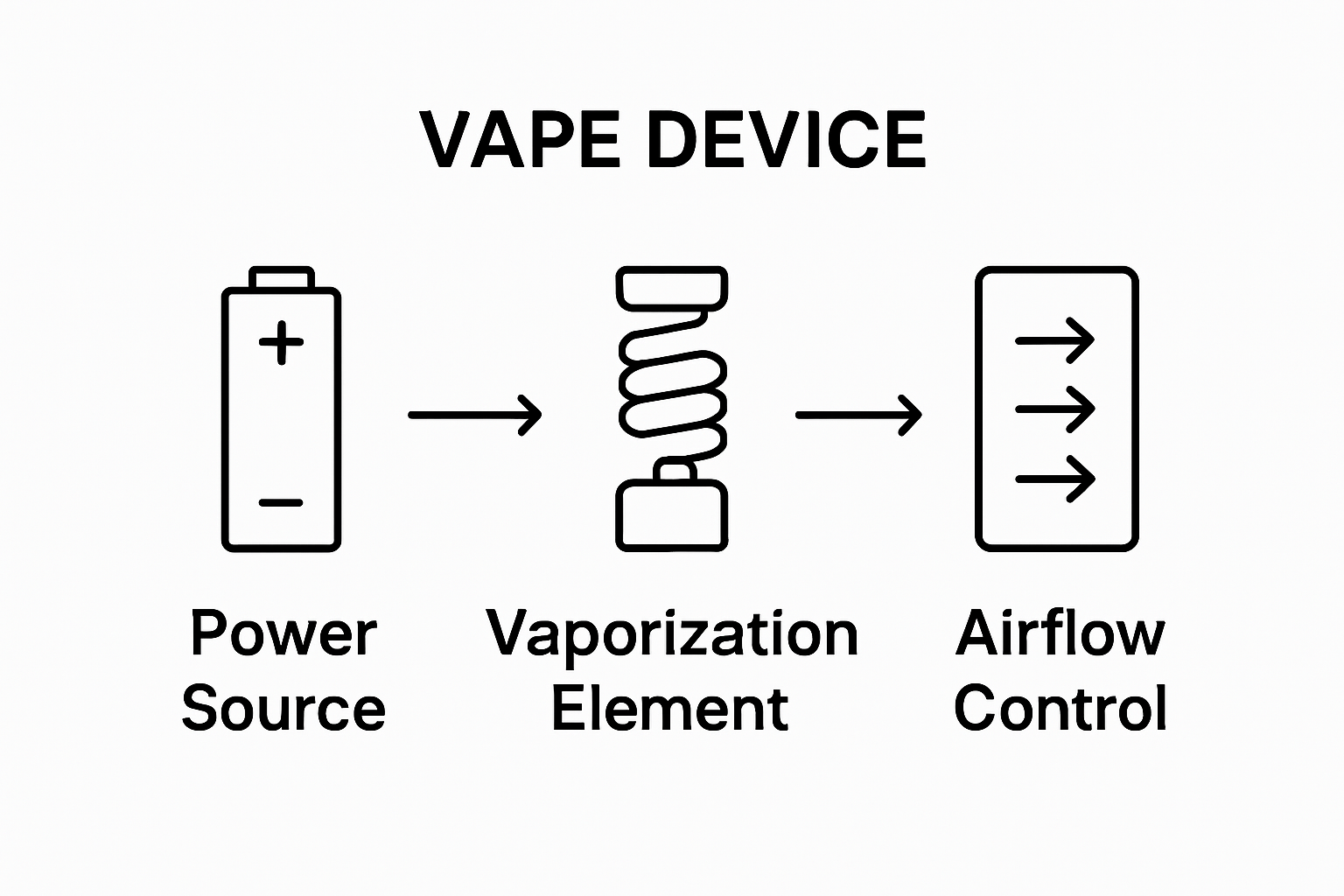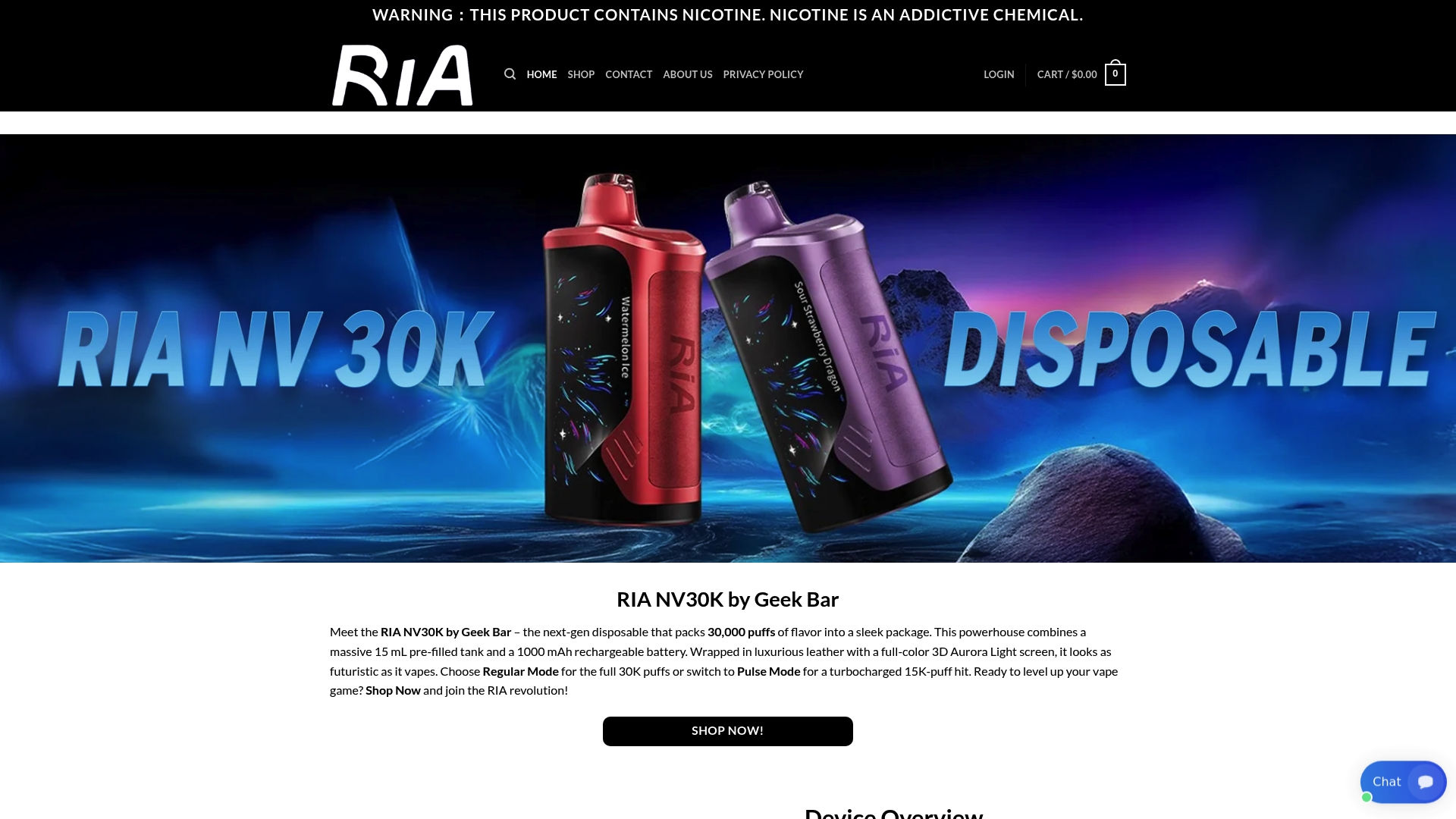Blog
Understanding the Role of Vape Device Design in Vaping

Vape device design is shaping the way millions enjoy nicotine and flavor, blending technology and personal style in one pocket-sized package. Shockingly, the placement of a single heating coil can change vapor production and flavor intensity by up to 40 percent. What most people overlook is how much the smallest design tweak can transform the entire experience, from safety to satisfaction.
Table of Contents
- What Is Vape Device Design And Why It Matters
- Key Components Of Vape Device Design Explained
- How Design Influences Vaping Experience And Performance
- The Importance Of Ergonomics And Aesthetics In Vape Devices
- Future Trends In Vape Device Design And User Preferences
Quick Summary
| Takeaway | Explanation |
|---|---|
| Device design impacts performance and safety. | The integration of components affects how well a vape device operates and ensures user safety. |
| Ergonomics enhance user experience. | Proper weight distribution and button placement ensure comfort and usability during vaping. |
| Materials science contributes to durability. | Carefully selected materials withstand heat and enhance structural integrity, improving device longevity. |
| Customization is a growing trend. | Users desire devices that can be tailored to their preferences, including performance specifications and aesthetics. |
| Regulatory compliance shapes design choices. | Manufacturers must innovate within safety standards, ensuring devices are both advanced and compliant. |
What is Vape Device Design and Why It Matters
Vape device design represents a sophisticated engineering process that goes far beyond aesthetic considerations. At its core, device design encompasses the strategic integration of technological components, materials, and functional elements that collectively determine a vaping device’s performance, user experience, and overall effectiveness.
The Fundamental Architecture of Vape Devices
A vape device’s design involves intricate considerations of multiple interconnected systems. Learn more about device engineering reveals that these systems include battery configuration, heating element placement, airflow mechanisms, and e-liquid delivery pathways. Each component plays a critical role in transforming liquid into inhalable vapor while maintaining consistent quality and user satisfaction.
The key architectural elements typically include:
- Battery Systems: Determining power output and device longevity
- Heating Coils: Controlling vapor production and flavor intensity
- Airflow Channels: Managing draw resistance and vapor density
Performance and Safety Implications
Design is not merely about functionality but also encompasses user safety and regulatory compliance. According to the National Academies of Sciences report, device design directly influences aerosol properties, which can impact potential health exposure. Advanced design considerations help mitigate risks associated with uncontrolled heating, battery stability, and consistent e-liquid vaporization.
Premium vape device design integrates multiple protective features such as:
- Precise temperature control mechanisms
- Short circuit prevention
- Overheat protection systems
- Leak-resistant compartments
Ultimately, vape device design represents a complex intersection of engineering, user experience, and technological innovation. The most successful designs seamlessly blend performance, safety, and user satisfaction into a single, sophisticated product.
Key Components of Vape Device Design Explained
Vape device design represents a complex integration of technological components that work together to create a reliable and efficient vaping experience. Understanding these key components provides insight into how modern vaping devices function and deliver consistent performance.
Electronic and Power Management Systems
Explore advanced device mechanics reveals that electronic systems form the backbone of modern vaping technology. The power management infrastructure includes sophisticated battery configurations, microprocessor controls, and safety circuitry that regulate electrical output, monitor temperature, and prevent potential malfunctions.
Critical electronic components include:

- Lithium Battery Units: Providing stable and consistent power delivery
- Microcontroller Chips: Managing electrical signals and device functionality
- Voltage Regulation Circuits: Ensuring consistent heating and vapor production
Heating and Vapor Generation Mechanisms
According to research published in the International Journal of Environmental Research and Public Health, the atomization process is fundamental to vape device performance. The heating element, typically a resistance wire coil wrapped around an absorbent material, transforms e-liquid into inhalable vapor through precise temperature control.
The vapor generation system involves intricate design considerations:
- Coil material selection (kanthal, nickel, stainless steel)
- Wicking material efficiency
- Precise temperature range management
- Airflow channel optimization
Material Science and Structural Design
Advanced vape device design integrates materials science principles to enhance durability, performance, and user experience. Engineers carefully select materials that withstand repeated heating cycles, resist corrosion, and maintain structural integrity while minimizing potential chemical interactions with e-liquid components.
The structural design goes beyond aesthetic considerations, focusing on:
- Thermal resistance
- Ergonomic user interaction
- Leak prevention mechanisms
- Modular component compatibility
By understanding these intricate design elements, users can appreciate the sophisticated engineering behind modern vaping devices and make more informed choices about their vaping equipment.
Below is a table comparing the key components of vape device design and their primary functions to help readers understand what each part contributes to the overall device.
| Component | Primary Function |
|---|---|
| Battery Systems | Provide power output and determine device longevity |
| Heating Coils | Control vapor production and flavor intensity |
| Airflow Channels | Manage draw resistance and vapor density |
| Electronic Systems | Regulate electrical output and monitor safety features |
| Structural Design | Ensure durability, ergonomic comfort, and leak prevention |
How Design Influences Vaping Experience and Performance
Vape device design is a sophisticated process that directly impacts user satisfaction, performance consistency, and overall vaping experience. Each design element contributes to creating a nuanced interaction between technology and user preferences.
Ergonomics and User Interaction
Discover high performance vaping solutions demonstrates how device design transcends mere functionality. Ergonomic considerations play a critical role in determining user comfort, ease of use, and overall engagement with the device.
Key ergonomic design factors include:
- Device Weight Distribution: Ensuring comfortable handling
- Button Placement: Facilitating intuitive control mechanisms
- Grip Texture: Providing secure and confident device management
Performance Optimization Strategies
According to systematic research on e-cigarette design, device architecture significantly influences vapor production, flavor intensity, and nicotine delivery. Advanced design strategies focus on creating precise environmental conditions for optimal vaporization.
Performance optimization elements involve:
- Precise temperature regulation systems
- Advanced airflow channel engineering
- Efficient heat distribution mechanisms
- Consistent electrical signal management
Psychological and Sensory Design Considerations
Beyond technical specifications, vape device design incorporates psychological and sensory elements that enhance user experience. Color, form factor, and material selection subtly influence user perception and interaction with the device.
Psychological design aspects encompass:
- Visual aesthetic appeal
- Tactile feedback quality
- Perceived technological sophistication
- Intuitive user interface design
By integrating sophisticated engineering principles with user centered design philosophy, manufacturers create vaping devices that offer more than just nicotine delivery a holistic sensory and technological experience.
The Importance of Ergonomics and Aesthetics in Vape Devices
Ergonomics and aesthetics represent critical yet often overlooked dimensions of vape device design that significantly impact user experience, satisfaction, and long term device engagement. These design elements transcend mere visual appeal, encompassing complex interactions between human perception, technological functionality, and sensory experience.
Ergonomic Design Principles
Explore premium device configurations reveals that ergonomic design involves meticulously crafting devices that align with human physical capabilities and comfort preferences. The goal extends beyond aesthetic considerations to create devices that feel natural and intuitive during use.
Key ergonomic design principles include:
- Weight Distribution: Ensuring balanced handling and reduced user fatigue
- Grip Geometry: Creating contours that match natural hand positioning
- Control Accessibility: Positioning buttons and interfaces for effortless interaction
Psychological Impact of Aesthetic Design
According to research exploring product design psychology, aesthetic elements profoundly influence user perception and interaction. Device appearance communicates technological sophistication, brand identity, and personal style, transforming vaping devices from mere functional tools into personal statements.
Psychological aesthetic considerations encompass:
- Color psychology and emotional resonance
- Material texture and perceived quality
- Visual symmetry and design harmony
- Symbolic representation of technological innovation
Functional Aesthetics and User Experience
Beyond visual appeal, functional aesthetics integrate design elements that enhance practical usability. Engineers carefully balance form and function, creating devices that are not just visually compelling but also technologically superior. Materials, surface treatments, and structural design work harmoniously to create a seamless user experience.
Functional aesthetic elements include:
- Thermal resistant exterior materials
- Precision manufactured components
- Intuitive interface design
- Seamless mechanical integration
By prioritizing ergonomics and aesthetics, manufacturers transform vaping devices from simple nicotine delivery systems into sophisticated, personalized technological experiences that resonate with user preferences and expectations.
The table below summarizes important ergonomic and aesthetic principles in vape device design, clarifying how they contribute to comfort, usability, and overall user satisfaction.
| Principle | Role in Vape Device Design |
|---|---|
| Weight Distribution | Balances the device for comfortable handling |
| Grip Geometry | Shapes contours for natural, secure hand positioning |
| Control Accessibility | Positions buttons/interfaces for effortless user interaction |
| Color and Material | Influences psychological appeal and perceived quality |
| Interface Design | Ensures intuitive, user-friendly operation |
Future Trends in Vape Device Design and User Preferences
The vaping technology landscape continues to evolve rapidly, driven by user demands, technological innovations, and sophisticated design philosophies that prioritize personalization, performance, and user experience. Future trends reflect a complex intersection of technological advancement, user psychology, and design engineering.
Technological Customization and Personalization
Discover next generation vaping solutions highlights the emerging trend of hyper personalized vaping experiences. Modern users seek devices that can be tailored not just in appearance, but in functional capabilities, allowing unprecedented levels of individual customization.
Key personalization trends include:
- Modular Device Architecture: Enabling component level customization
- Smart Connectivity: Integrating mobile app based device management
- Dynamic Performance Profiles: Adjustable vapor production and nicotine delivery
Consumer Preference Shifts
According to experimental research on product characteristics, consumer preferences are increasingly driven by devices that offer comprehensive customization options. Users now expect more than standard functionality they desire technological experiences that reflect individual lifestyle and technological sophistication.
Emerging consumer preference indicators include:
- Demand for intelligent device interfaces
- Preference for sleek, minimalist design aesthetics
- Interest in environmentally sustainable materials
- Emphasis on precision engineering
Regulatory and Design Compliance
Future vape device design must navigate complex regulatory landscapes while maintaining user appeal. Manufacturers are developing innovative design strategies that balance regulatory requirements with cutting edge technological features. This involves creating devices that are not just technologically advanced but also inherently compliant with evolving safety standards.
Compliance driven design considerations encompass:
- Advanced safety circuit integration
- Standardized component specifications
- Transparent manufacturing processes
- Enhanced user control mechanisms
As vaping technology progresses, device design will continue to be a critical factor in defining user experience, balancing technological innovation with user specific preferences and regulatory expectations.
Experience the Power of Thoughtful Vape Device Design with RIA NV30K
Are you tired of unreliable vape devices that do not deliver consistent quality or fail when you need them most? The article highlighted how vape device design directly affects your satisfaction, performance, and safety. From the engineering of battery systems to innovative airflow and ergonomic design, every detail matters when choosing a high-capacity disposable vape. Choosing a device built with advanced technology solves common frustrations such as weak vapor production, uncomfortable handling, or frequent leaks.

Why settle for compromise when you can get a true innovation? At Official RIA Vape, every RIA NV30K combines luxury craftsmanship with premium engineering. What does this mean for you? Up to 30,000 puffs per device, striking full-color displays, and user-friendly rechargeable batteries. Looking for even more details? Explore the RIA NV30K product page to see how our design principles translate to real-world performance. Your search for a reliable and high-performance disposable vape ends here. Visit https://officialriavape.com now and elevate your vaping experience today.
Frequently Asked Questions
What are the key components of vape device design?
The key components of vape device design include battery systems, heating coils, airflow channels, and electronic power management systems. Each of these elements plays a crucial role in determining the device’s performance and user experience.
How does vape device design impact user safety?
Vape device design directly influences user safety through features like precise temperature control, short circuit prevention, and leak-resistant components. These design aspects help mitigate risks associated with overheating and ensure consistent vaporization of e-liquids.
What is the importance of ergonomic design in vaping devices?
Ergonomic design is vital in vaping devices as it enhances user comfort and ease of use. Key factors include weight distribution, button placement, and grip texture, all of which contribute to a satisfying vaping experience and reduce user fatigue.
What trends are shaping the future of vape device design?
Future trends in vape device design include technological customization, modular architecture for personalization, smart connectivity for device management, and an emphasis on compliance with regulatory standards while ensuring user appeal.
